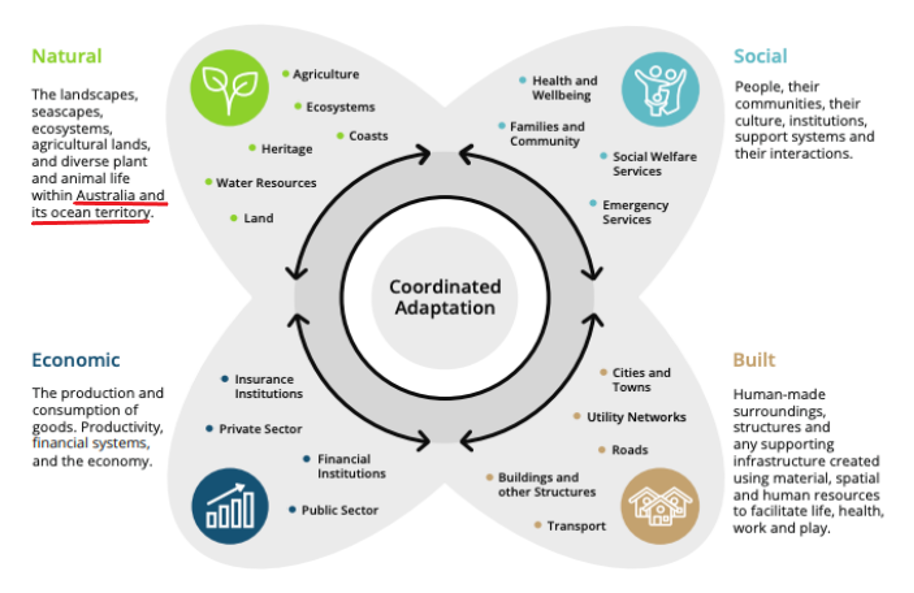On Wednesday, 26 July 2023 the federal cabinet approved the eagerly awaited National Adaptation Plan which is built with the focus on protecting vulnerable populations from the devastating impacts of climate change. Just a day before the approval, the Climate Change minister Sherry Rehman had tweeted a silent video of her discussing intently the contents displayed on a Macbook with her team at the MoCC office where everyone was more or less color-coordinated.
“Burning the midnight oil with the team @ClimateChangePK to leave behind a National Adaptation Plan that’s home-grown, inclusive and reflective of Pakistan’s growing challenges from mountain to delta. All such plans must be works-in -progress, but we must start somewhere, given the accelerated need for resilience.” she tweeted with the video.
After the January 2023 International Conference on Climate Resilient Pakistan, a lot of eyes in the world turned towards the Climate Change ministry’s ability to come up with a national adaptation plan. In March 2023, the UN Secretary-General António Guterres said in a video message for the press conference to launch the Synthesis Report of the Intergovernmental Panel on Climate Change (IPCC), “Dear friends, humanity is on thin ice – and that ice is melting fast.” This statement best describes the stage of the climate crisis that Pakistan is in at the moment.
Floodwater has already inundated multiple houses in Ayun valley, Chitral and resulted in landsliding which has completely blocked entry and exit from Lipa valley this year. Earlier, in January the European Union approved a Rs 7.86 billion grant for climate resilience and sustainability-based projects in Chitral, Gilgit-Baltistan and KP. But instead of diverting it to more sustainable and long-term projects it was announced that the grant will be used to build energy projects.

The United Nations Development Program (UNDP) has supported 35 countries, including Pakistan and all four of its neighbors, to advance their National Adaptation Plans processes with funding from the Green Climate Fund Readiness Programme. It grants funding for up to $3 million to support initiatives which strengthen their institutional capacities, governance mechanisms, and planning and programming frameworks towards a transformational long-term climate action agenda.
What does the policy really say?
The “Pakistan National Climate Resilience and Adaptation Plan 2023-2030”, prepared by the Ministry of Climate Change, sets itself up in the executive summary to not only lay a groundwork of climate resilient ideas and address the gaps but also deal with preparatory elements, implementation strategies and evaluation of those strategies.
This document aims to provide a guiding framework for addressing the challenges and opportunities of climate change in Pakistan, and to outline the strategies and actions for enhancing the resilience and adaptive capacity of various sectors and stakeholders in 8 vulnerable sectors identified by the report as follows: Water Resource, Agriculture & Livestock, Forestry, Human Health, Biodiversity and other Living Ecosystems, Disaster Preparedness, Urban Resilience and Gender. The policy holds the MoCC responsible for the complete implementation of this plan and the coordination and establishment of Pakistan National Adaptation Fund (NAF).
Chapter one of the policy, National Circumstances provides an introduction to the physiography, demography, climatic conditions, climate change impacts, issues and challenges, loss and damage, response and reclamation, and international environmental commitments and obligations of Pakistan.
NAP mentions, “There has been a significant rise in climate induced migration in the country, totaling at nearly 20 million people a lot of these migrations have also been a direct result of displacement”, says the policy paper. The katchi abadis of Islamabad, the housing settlements surrounding Gujjar Nala and Orangi Nala in Karachi, were evacuated after several decades of residents living there, although the reason that the authorities cite in the case of Karachi is urban flooding but this displacement is a man-made response to climate change, and a very ill-thought one.
In a 64:36 rural to urban population divide, Pakistan has the highest fertility rate (3.8%) in Asia. But the country falls at 154 in the ranking of 189 countries according to their human development index. The policy notes the need to establish early warning systems and build constructive rehabilitation policies despite making little attempt to demonstrate how. There was very little attention to detail, in fact a diagram explaining how the Natural, Economic, Social and Built environment needs to work in harmony for effective coordinated adaptation, was copied from a policy document from Australia.
The NAP 2023 highlights some key achievements of past governments and includes the Ten Billion Tree Tsunami Programme, Ban on Polythene Bags and the National Hazardous Waste Management Policy. However, it has been clear over the years that these steps have not rendered the fruitful results as promised. In June 2022, it was noted that Karachi generates 472 gallons of sewage water every single day and more than 68% of it flows into the ocean, untreated.

After Imran Khan’s government announced the plan for the Ten Billion Tree Tsunami Programme in 2019, it was launched with the support of the United Nations Environment Programme. But environmentalists have claimed this to be an unsustainable and expensive waste of resources, citing reasons such as the lack of financial transparency, bureaucratic control over the natural environment instead of experts and environmental scientists, and the lack of consideration to tertiary environmental impacts such as diminishing grazing grounds.
NAP includes a comprehensive analysis of existing climatic data but it is only limited to 2010, there is a general lack of updated climactic records and statistics. This plan presents the observed and projected changes in temperature, precipitation, and extreme events in Pakistan based on historical data and global circulation models. Pakistan has experienced a significant warming trend in the last 50 years, with more pronounced effects in winter and post-monsoon months, and in the southern regions. It also shows that precipitation patterns have become more erratic and variable, with shifts in monsoon onset and intensity. The plan notes the rise in extreme events such as heat waves, floods, droughts, cyclones, and glacial lake outburst floods (GLOFs), posing serious threats to lives, livelihoods, infrastructure, and ecosystems.
Chapter 3 of the plan identifies the key sectors that are vulnerable to climate change impacts in Pakistan, and proposes adaptation strategies and actions for each sector. The eight vulnerable sectors are: water resources, agriculture and livestock, disaster preparedness, human health, forestry, biodiversity and other living ecosystems, gender, and urban resilience. The proposal vaguely touches upon some action steps to execute but never really defines what these action steps mean, what kind of chain-of-command will be set up to bring them about and what are the key areas within bureaucracy around the natural environment which need revamping. In the discussion on water resources, there is no acknowledgement of existing systemic hurdles such as water mafia and the incapacities of water management authorities. The table of solutions in the categorization of ‘short’, ‘medium’, and ‘long term’ solutions, are descriptive sentences which any graduate student should be able to write with a few days of online research. Instead of discussing land reforms, better regulation on industrial usage of land, the plan focuses on the way in which the agriculture industry is causing pollution without including real and concrete examples or demonstrations on how to tackle that problem.
Fortunately, in the case of disaster preparedness, the plan elaborates on how the NDMA has identified disaster-vulnerable districts but still fails to acknowledge or explain how the National Disaster Risk Reduction Strategy (2013) would be implemented differently to prevent the humongous loss of life and economy that Pakistan faced during the June 2022 floods. NAP lists down comprehensively the various kinds of natural disasters Pakistan has faced in recent years and intelligently notes the rise in trends. However, when discussing hurdles to biodiversity, the report conveniently ignores the various attacks on biodiversity in the name of unfettered and unfeasible development, the destruction of habitats in Thar by Sindh Engro Coal Mining Company, the devastation of the Kirthar National Park to build the Malir Expressway and the handing over of protected forests to the military in the name corporate agriculture farming. The plan proposes an Ecosystems Restoration Initiative (ESRI) which would develop model protected areas to conserve 7300 sq kms of land area and create 5000 green jobs. MoCC claims that through this initiative, Pakistan has expanded the protected area coverage to at least 17 percent.

A welcome news is that the MoCC explained the adoption of a monitoring, reporting and evaluation platform called ‘Pakistan Transparency Platform (RISQ)’, which is currently being developed by Global Climate Impact Studies Centre (GCISC) with the support of Centre Interprofessione Technique d’Etudes de la Pollution Atmospherique (CITEPA) France. Through this portal, citizens and researchers can hopefully keep track of the developments promised under NAP. The report mentioned various methods of engaging in public sector development projects, ensuring financing via opportunities such as Green Climate Fund (GCF). This plan approximates that from now on to 2050, around $6-14 billion will be spent on adaptation planning. “Currently, CC expenditure, both on mitigation and adaptation (investment and re-current) is to the tune of only US $5.0 billion. Apart from the existence of a narrow fiscal space, there are, however, many challenges related to the implementation of CC-related investments. These are: overriding and pressing governmental challenges such as security and energy supply, prioritization of CC responses, coordination and facilitation of CC across sectors and provinces, and the development of sector / provincial CC policies and strategies.” The plan notes.
Concerns and considerations
Despite welcoming the decision, experts have voiced concerns regarding the feasibility of its implementation strategies. “It was needed. It’s well written. And it explicitly speaks to the vulnerability of marginalised communities. However, it’s weak on plans to mainstream adaptation at the provincial and local level, and weak on how to leverage private sector finance.” said Ahmad Rafay Alam, environmental activist and lawyer who spends his time filing important public interest litigation. Profit also spoke to Imran Saqib Khalid, Director Governance and Policy at World Wildlife Federation (WWF) Pakistan. “It has been years in the making. Ideally we should have developed it following our climate policy in 2013. But we waited for UNEP to fund this initiative. And then waited some more.What is truly needed are local level adaptation plans. It is at the District and Tehsil level where adaptation truly happens.”
It is safe to say that the most common criticism of the National Adaptation Plan is how it falls short on its ability to comprehensively chart actionable steps for each identified goal and an authentic and genuine articulation of the obstacles that the state faces in their attempts to take these steps. “National plans can provide broad based guidance but unless and until there are concerted efforts to focus on local needs and local planning, we will remain at sea in terms of responding to the climate crisis. And there is no evidence to suggest that concerted efforts are afoot in this regard. Quite strange for a country that routinely reminds the world of its vulnerability to the climate crisis!” said Imran Khalid.
Chapter 4 of the NAP concerns the current climate governance framework and key institutions in Pakistan at the national and sub-national levels. It also reviews the existing policies, strategies, plans, and legal frameworks that are relevant to climate change adaptation. Moreover, it proposes a coordination mechanism and institutional roles for the NAP process that involves various actors such as the national focal point (NFP), sectoral climate adaptation cells (SCACs), national working group for cross-cutting national adaptation needs (NWG), regional climate cells (RCCs), civil society organizations (CSO) forum, Pakistan Climate Change Council (PCCC), and national steering committee (NSC). Despite pages and pages of explanation on the bureaucracy behind the implementation of NAP, there was little to now information regarding various non-governmental stakeholders, their responses and concerns or the mitigation of the same. “There is a need to ensure that the development of national level plans involves a detailed consultative process with all stakeholders. Consider the fact that not even the National Climate Change Council was kept in the loop before finalization of the document.” said Imran Khalid. “It is important to note that it is the process that defines the substance. As such, if the process is faulty, as was the case with development of NAP and many other national documents before it, then the substance itself becomes moot.”
Perhaps it would be wiser to understand the recent key developments in these thematic areas rather than coming up with redundant phrases to define the same. Dr Nousheen Zaidi, with the help of Action Research Collective recently published a detailed study explaining how water in various parts of Lahore is contaminated due to a lack of regulation and basic expertise to even test the water adequately. Lead Exposure Elimination Project (LEEP) is a research endeavor undertaken by Aga Khan University which announced in February 2023 that the presence of lead is pervasive in paint, emphasizing that some paints contained 1000 times above the limit prescribed by the World Health Organization. Pakistan suffers from a history of ill-planning of urban settlements resulting in mass evictions, pushing urban poverty further towards the edge. Pakistan is the world’s second largest importer of refrigerant R-22 which has been banned in most parts of the world and being phased out in others.
Pakistan is faced not with just a lack of loosely framed open-ended adaptation policy, but what it needs is a consolidated understanding at each hierarchical stage of the bureaucracy and government that the ice is thin and it is melting fast and that if we do not develop a national war chest to deal with the climate crisis, there will be no nation left to save.
“The rate of temperature rise in the last half century is the highest in 2,000 years. Concentrations of carbon dioxide are at their highest in at least 2 million years. The climate time-bomb is ticking.” said António Guterres, humanity is on the brink of extinction and the climate crisis is now more significant than any national security threat – no stone must be left unturned. Pakistan’s carbon footprint is negligible compared to the first world countries but unfortunately we are prone to the worst effects of climate change. It is therefore crucial that we act now, for our sake. When it comes to climate catastrophes, there are no bailouts, like the ones we get for our financial woes. The only way to deal with it is preemptive timely action.


























My name is Castro, an expatriate living in Maryland, USA. Am so overwhelmed with gratitude to let the world know how CYBER GENIE. A great cryptocurrency recovery expert who changed my life for good. It all started when I lost my job and I was down financially. Investing in cryptocurrencies is a good idea, but when I first started, I made a mistake and invested in the wrong company, which took over $179,000 from me. It was a terrible time, and I was in need of help recovering my crypto funds as I wasn’t even able to provide for my two kids because I had invested wrongfully and had no job or any more savings. I saw a series of testimonies by people on how they were assisted by Cyber Genie. I honestly didn’t believe it, but after noticing that these testimonials are from different parts of the world, and being poor with lots of debts and a family to care for, I had no choice but to give them a shot. I consulted them for assistance, they ruled out their working terms, and we agreed and they commenced working. Please get in touch with this crypto recovery expert if you had invested wrongfully with a fake crypto broker or investment website. I am writing this testimony to express my utmost gratitude and satisfaction with the exceptional services provided by Cyber Genie Recovery Expert. Their expertise and dedication resulted in me recovering my investment and profits at the same time after months of pleading with the cocky broker to let me have access to all I had sent. Their info are: [ CyberGenie(@)CyberServices.C OM ][ Whatsapp, + -1 -2-5’2’5-1-2-0’3-9’1 ]